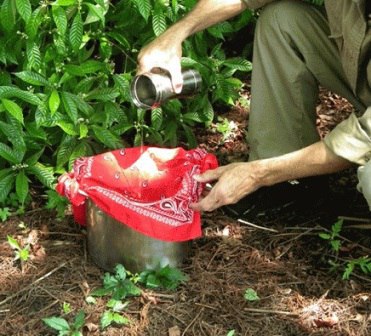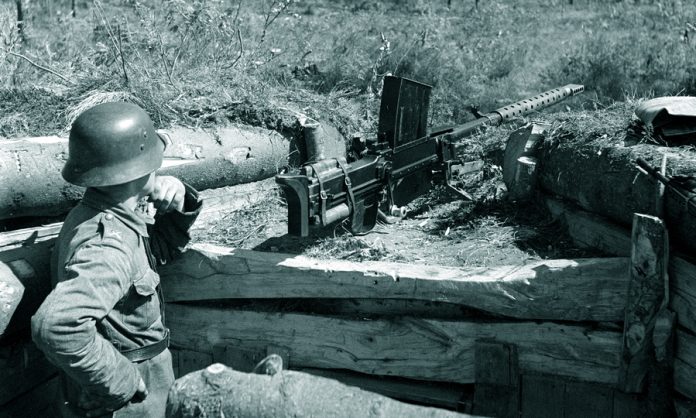
In the 30's Finnish military with great fear glancing in the direction of its large neighbor to the east. Of attaché posts, intelligence, and just from the media should, that is getting a lot of Soviet tanks, and then a lot of.
Of course, by the standards of the Soviet-Finnish border it was not the most convenient place for the massive use of tanks. Nevertheless, it was not the English Channel, to relax and to look at photos from the parade or the next "big maneuvers". I had to think, how to solve this problem with considering the modest possibilities.
One step behind
Manufacturing capabilities of Finland did not allow her to expand production even anti-tank guns, not to mention their own tanks. Good 37-mm guns were in neighboring Sweden, but the company "Bofors" not engaged in charity. In these circumstances, the development of a light anti-tank weapons looked reasonable measure: Firearms Finns could do. Furthermore, at the state arms factory VKT (State Rifle Factory) already working man, capable of creating the desired weapon - Aimo Lahti.
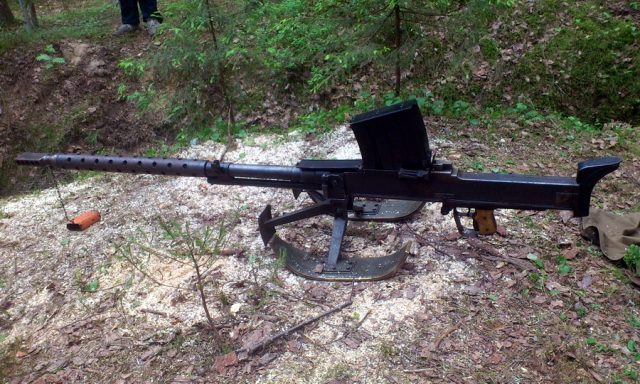 Surviving to the present day anti-tank gun "Lahti» L-39 - a museum piece
Surviving to the present day anti-tank gun "Lahti» L-39 - a museum piece
The problem was in another: Finnish military is not that at all did not know, what it wants, but like all different. At first, to be solved, do antitank rifle, or just wipe the anti-tank gun. Secondly, even more disagreement was on the caliber.
some thought, that will be enough 12,7 mm: British large-caliber machine gun "Vickers D" chambered 12,7 × 120SR mm was in the early 1930s acquired Finns test. Others focused on the French 13.2-mm cartridge for a large caliber "Gochkissa", at that time widespread in Europe.
Lahti himself inclined to move immediately to the 20-mm cartridge, because he was not satisfied with the capabilities of bullets smaller. Besides, he thought, that to get good armor penetration, in any case, require the development of new ammunition. But, yet it was only his personal opinion, he was forced to spend time, energy and resources on working off 13.2-mm machine guns.
Taking the patron of "Vickers" mentioned above, Finns have developed some of its own options with different munition sleeve length. Build new ammunition was conducted on VKT, bullets were made partly in the same place, and partly purchased from the French and Hungarian. As for the sleeves, part of them have made themselves Finns, but most had to buy from the Germans from DMW.
Finally, special spice in hot soup Finnish Colonel added a view Raatikaynena (Raatikainen) the installation of the new weapons. Raatikaynen was the head of the arms division at the Defense Ministry, and oversaw the development of new weapons. His dream was to combine the capabilities of anti-tank and anti-aircraft gun in one sample.
Lahti insisted, that option, capable of providing an acceptable fire on air targets, it will be very bad in the role of anti. Besides, Raatikaynen together with another employee for weapons development committee insisted on the use of the design of the Swiss "Oerlikon" - so active, Lahti suspected that their personal financial interest in the matter.
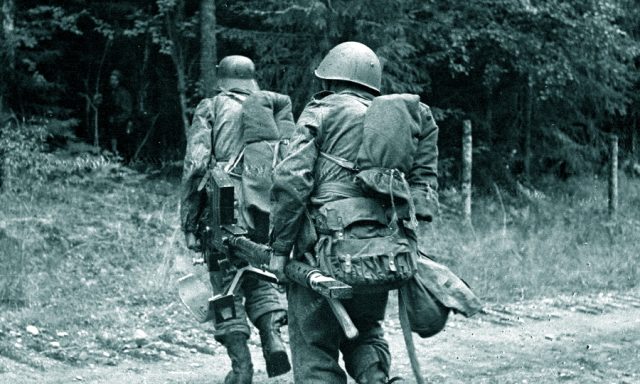 Carrying "Lahti» L-39 calculation. As it appears, Finnish anti-tank riflemen on the march might envy their Soviet "colleagues", gun which weighed 2-3 times less
Carrying "Lahti» L-39 calculation. As it appears, Finnish anti-tank riflemen on the march might envy their Soviet "colleagues", gun which weighed 2-3 times less
As a result, a series carried out in the summer 1939 year tests showed, Aimo Lahti that was right, referring to the lack of penetration of 13.2 mm ammunition, but there is no time left. Although the Finns themselves write, What's new 20-mm antitank rifle L-39 It was developed in just three weeks, to top "Winter War" was made only two prototypes of the future L-39 developed by Lahti chuck 20 × 113 mm.
test cycle combined with the reflection of the Soviet attack on the fortified Taipale: Finnish data for, of the new MFI managed to knock out four Soviet tank. More anti-tank rifle VKT plant could not produce, since the outbreak of war was literally swamped with urgent work - primarily for repair of weapons.
in front of, reviews of attempts to apply at the front made earlier 13.2-mm machine guns were disappointing. At first, at low temperature, they are regularly denied, and when they are able to make fire, It turns out that something like "Quiet tank T-26 fired from a distance 30 meters without visible results ".
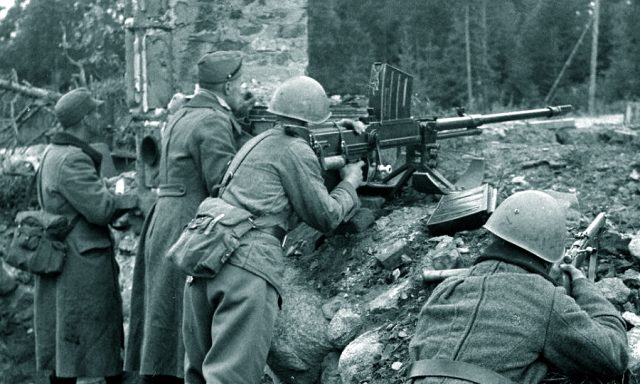 Calculation of antitank rifle L-39 in the battle of Viborg, August 1941 of the year
Calculation of antitank rifle L-39 in the battle of Viborg, August 1941 of the year
Only after the conclusion of the Moscow Treaty 1940 year VKT could begin mass production of a new MFI. At this point, Lahti decided to use his gun cartridge 20 × 138B (also known as Lang Solothurn). At first, this ammunition could always share the German Allies, Secondly, use of a longer sleeve possible to increase the initial rate, and, respectively, be penetrated.
Cartridges also needed a lot - this time on the basis of its MFR Aimo Lahti has also developed anti-aircraft gun 20 ItK 40 VKT. In fact, It was the same Spark L-39, adapted for firing bursts.
By the beginning of "Continuation War" Finnish army fully received its first order from 410 PTR "Lahti" L-39. Making a second order for another 496 PTR, issued in March 1941 of the year, It stretched until December.
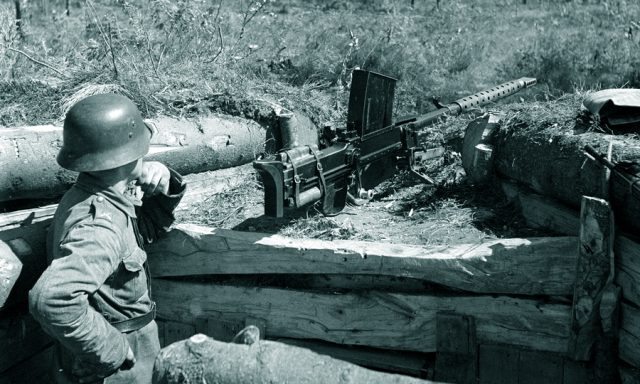 The painful waiting on the fitted position: who comes out of the woods, T-26 or HF?
The painful waiting on the fitted position: who comes out of the woods, T-26 or HF?
However, by this time the Finns had already begun to understand, that lost time. In the first months of the war in their sector of the front still have enough tanks of old types, with anti-armor which L-39 copes. But the farther, the more the phrase "Soviet tanks" meant KV or "Tridtsatchetvorki", against whom, and 20-mm armor-piercing shell was little he could do.
but, even realizing hopelessness "Lahti» L-39 as an anti-tank means, Finns do not rush to throw it. At first, gun turned out quite effectively in the shooting of the so-called "soft targets": embrasures bunkers, machine-gun point, artillery for direct fire, protective shield which is easily penetrated 20 mm projectiles, and even as a weapon kontrsnayperskoe.
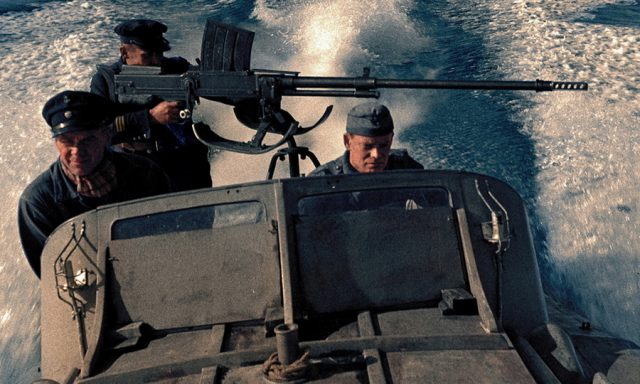 Antitank rifle "Lahti» L-39 as a light weapons patrol boat
Antitank rifle "Lahti» L-39 as a light weapons patrol boat
Secondly, familiarity with the Il-2, low vulnerability to conventional caliber rifle, quickly developed the Finns desire palnut on it from something heavier. TO 1944 Finnish command was awakened and formally issued the order for L-39/44 with the possibility of firing bursts. At the same time in the "anti-aircraft guns" have altered the order 100 previously released "Lahti".
Finnish MFI as the Soviet trophy
On Research polygon infantry weapons of the Red Army (NIPSVO CA) trophy Finnish gun has got a relatively late - in August 1944 of the year, literally in the last days of the Finnish participation in the war on the side of the Axis. This is easily explained: before setting the position of the front near Leningrad not very favorable to the capture of trophies.
But during the Soviet offensive in the summer 1944 the Finnish army has lost a significant amount of L-39, that, one side, by this time had very limited military value, and on the other, It was commonplace too heavy, so that calculations are not tempted to throw them in the retreat.
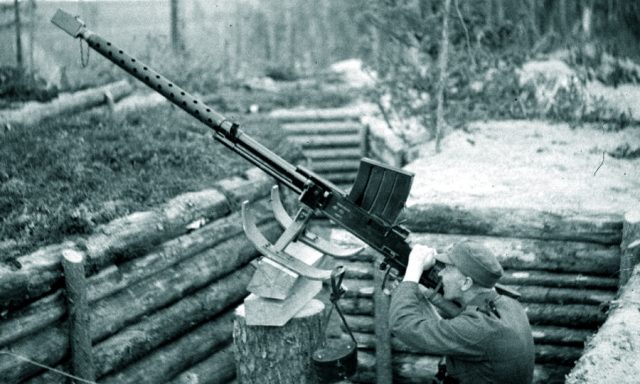 Anti-tank gun L-39 on an improvised anti-aircraft guns. Ontayoki, June 1944 of the year
Anti-tank gun L-39 on an improvised anti-aircraft guns. Ontayoki, June 1944 of the year
The Soviet test interest was not only the gun, but also a wide range of captured ammunition with him - they were four different types. Notably, if shells with brass sleeve "Lahti" firing properly, then using ammunition with steel case occurred constantly well-known domestic testers cases tight extraction, in some cases accompanied by disruption of the bead:
"... Then manually reload the rifle is also impossible, and remove the liner is very difficult to use the ramrod. In this case, the ramrod is necessary to conduct a series of blows heavy hammer ".
Conclusions test small test site on the PTR "Lahti" were as follows:
«1. On gun design as a whole and individual sites. Finnish anti-tank gun caliber 20 mm is self-loading, equipment which operates on the principle of removal of powder gases through the lateral opening in the barrel. A typical automatic rifle in a separate structure from the piston rod of the frame, a wedge reacting with locking parts of the locking mechanism similar to the shutter locking the tilting up.
In general, interest in weapons design for the national weapons technology is not. Separate units and gun mechanisms constructively to some extent original and can attract the attention of domestic designers, in terms of approach to the resolution of certain issues the construction of an assembly or mechanism. These sites and mechanisms should include:
1) muzzle brake;
2) reloading mechanism;
3) trigger to the presence of a separate mechanism for lowering the hammer;
4) bipod structure with a cushioning device, stability-enhancing gun shooting.
You should also pay attention to the way automatic protection from dust during transportation and the possibility of adjusting the height of the shoulder rest, that allows you to modify it according to physique and shooting skills.
In addition to the above, in the construction of individual components and mechanisms of a number of small, by its significance, but the original decisions, It is also of interest for domestic designers ...
According to its maneuverability Finnish MFI sample 1939 year is much lower, having more weight, than PTRD, at 2,86 times and in 2,56 times more, than PTSD. In size Finnish MFI sample 1939 It was also inferior to domestic PTRD guns and PTSD.
Martial qualities of Finnish MFI sample 1939 year is much lower than domestic PTRD guns and PTSD and gives less armor penetration is approximately twice. So, thick armor 30 Finnish mm gun breaks only with a maximum distance 175 m (when firing armor-piercing incendiary tracer shells), while domestic gun PTRD and PTSD pierce armor with the same range of order 300–350 m. Low armor Finnish rifles explained by the relatively low velocity of the projectile - 825 meters per second".
"Lahti" appeared a few years earlier, it could cause a lot of problems to Soviet tank crews during the "Winter War", when the bulk of the Red Army tanks was introduced machines with anti-bullet armor. But in this war, "Lahti" too late, and the next time the Finnish Army faced Soviet tanks fundamentally different level of reservation, hit that L-39 could only with very big success.
/Andrey Ulanov, warspot.ru/








